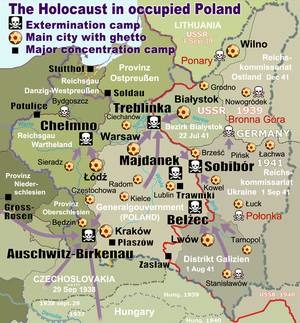Difference between revisions of "Death Camps"
| Line 5: | Line 5: | ||
* [[Chelmno]] -- [[Treblinka]] -- [[Belzec]] -- [[Sobibor]] -- [[Majdanek]] -- [[Auschwitz]]. | * [[Chelmno]] -- [[Treblinka]] -- [[Belzec]] -- [[Sobibor]] -- [[Majdanek]] -- [[Auschwitz]]. | ||
* [[ | * [[Nazi Ghettos]] -- [[Internment Camps]] -- [[Transit Camps]] -- [[Concentration Camps]] -- [[Death Camps]] | ||
== Overview == | == Overview == | ||
Revision as of 08:02, 30 March 2021
Death Camps (see Holocaust Children Studies)
Overview
Death Camps were established (beginning of 1942) with the only purpose of mass killing.
If one was sent to Chelmno, Treblinka, Belzec, or Sobibor, changes of survival (for children and adults as well) were virtually nil. People were killed on arrival by carbon dioxide in vans (Chelmno) or gas chambers (Treblinka, Belzec, Sobibor). There was no selection. Only a few laborers were randomly spared for a limited time and then killed and replaced by others. Thousands and thousands of children died there. We know of only one child who survived at Chelmno as an errand boy, and a couple of teenagers who managed to escape from Sobibor during a revolt.
Two major Death Camps (Majdanek & Auschwitz) functioned also as Concentration Camps. Older children might pass the selection if they looked strong enough for forced labor, a few younger children could be selected as errand boys. Chances of survival in Concentration Camps remained very low.
Some Death Camps (Chelmno, Treblinka, Belzec, Sobibor) were totally dismantled after completing the killing. The Nazis tried to erase all traces of their existence to the point of exhuming the corpses from mass graves, burning them, shredding the bones and scattering the ashes. Majdanek and Auschwitz continued to operate as Death Camps until November 1944 and as concentration camps until Liberation.
